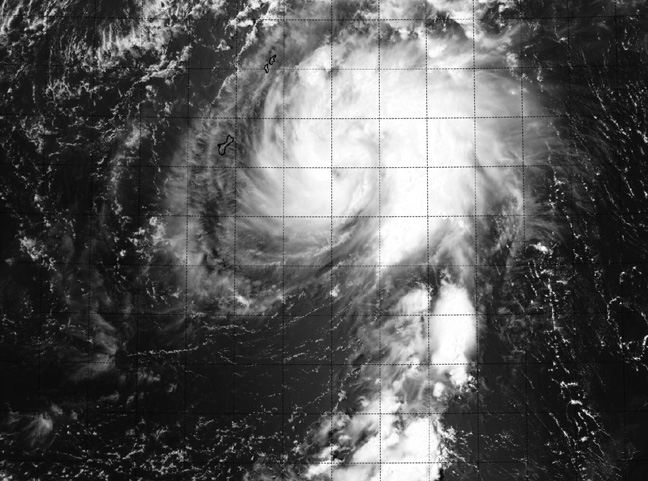Newborn Tropical Storm Tapah Threatens Saipan and Tinian

When NASA-NOAA's Suomi NPP satellite passed over Tropical Storm Tapah on April 28 imagery revealed a developing eye surrounded by a thick band of thunderstorms. Image Credit: NRL/NASA/NOAA
In addition to the tropical storm warning, a typhoon watch is in effect for Alamagan and Pagan as Tapah is expected to continue in a generally northerly direction over the next couple of days.
A typhoon watch means typhoon force winds of 74 mph or greater are possible within 48 hours. A tropical storm warning means tropical storm force winds of 39 mph to 73 mph are possible within 24 hours.
NASA-NOAA's Suomi NPP satellite captured an image of Tapah as it passed overhead on April 28 at 03:21 UTC (April 27 at 11:21 p.m. EDT) and the VIIRS instrument aboard captured a visible image that showed an eye surrounded by bands of thunderstorms around the center of circulation, and a large band of thunderstorms wrapping around the eastern quadrant and spiraling into the center.
On April 28 at 1500 UTC/10 a.m. EDT, Tropical Storm Tapah had maximum sustained winds near 50 knots/57.5 mph/92.6 kph. It was centered near 14.2 north latitude and 147.4 east longitude, about 121 nautical miles/139 miles/224 km east of Andersen Air Force Base, Guam.
Tapah is moving north at 6 knots/6.9 mph/11.1 kph and the Joint Typhoon Warning Center expects a turn to the northwest. The storm is expected to strengthen into a typhoon sometime on April 29.
According to the National Weather Service bulletin in Guam, Tropical Storm Tapah is expected to intensify…possibly reaching typhoon intensity this evening (April 29, 2 a.m. local time, Guam) before beginning a gradual weakening trend Wednesday.
For local bulletins for Guam, visit: http://www.prh.noaa.gov/guam/cyclone.php
Text credit: Rob Gutro
NASA's Goddard Space Flight Center
Media Contact
More Information:
http://www.nasa.gov/content/goddard/tapah-northwestern-pacific-ocean/All latest news from the category: Earth Sciences
Earth Sciences (also referred to as Geosciences), which deals with basic issues surrounding our planet, plays a vital role in the area of energy and raw materials supply.
Earth Sciences comprises subjects such as geology, geography, geological informatics, paleontology, mineralogy, petrography, crystallography, geophysics, geodesy, glaciology, cartography, photogrammetry, meteorology and seismology, early-warning systems, earthquake research and polar research.
Newest articles

Superradiant atoms could push the boundaries of how precisely time can be measured
Superradiant atoms can help us measure time more precisely than ever. In a new study, researchers from the University of Copenhagen present a new method for measuring the time interval,…

Ion thermoelectric conversion devices for near room temperature
The electrode sheet of the thermoelectric device consists of ionic hydrogel, which is sandwiched between the electrodes to form, and the Prussian blue on the electrode undergoes a redox reaction…

Zap Energy achieves 37-million-degree temperatures in a compact device
New publication reports record electron temperatures for a small-scale, sheared-flow-stabilized Z-pinch fusion device. In the nine decades since humans first produced fusion reactions, only a few fusion technologies have demonstrated…





















